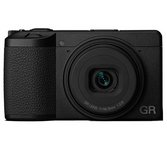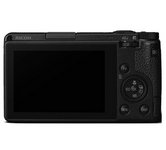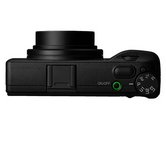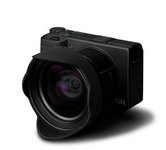Ricoh GR III Fixed-Lens
APS-C CameraProduct Gallery




Product Overview
Ricoh GR III is a high-end APS-C compact camera. Introduced by Ricoh in 2018, it comes with an APS-C sensor with 24 MP (6000 x 4000) resolution.
The camera has a poor battery life, and a second or third battery may be needed to get you through the day. The GR III's 4.0 fps burst rate limits its use for certain types of photography, but it is hardly something that most photographers should worry about.
Those who intend to use the Ricoh GR III for video work will be glad to find that the camera comes with 4 stops of IBIS. Last but not least, the camera can focus quite close to the subject.
Ratings
What we found
Neofiliac score 66%
Pros
- 4 stops of IBIS
- Very light
- Supports both WiFi and Bluetooth
Cons
- Poor battery life
- Very low 4.0 fps burst rate
What external reviewers found
External score 59%
Pros
- Superb image quality
- Great dynamic range
Cons
- Poor battery life
- Lacklustre video quality
- No optical zoom
- No USB-C port
- No tilting display
- No 5K video
Your rating:
12345678910
?/10
Price Comparison
As associates of the merchants above, we earn a commission when you make a purchase using the supplied links.
Specifications
[{"Ft":"Connectivity","Fn":"Ports","Fv":"Remote Control + USB 3.0"},{"Ft":"Connectivity","Fn":"Wireless Connectivity","Fv":"802.11b/g/n + Bluetooth"},{"Ft":"Construction","Fn":"Form Factor","Fv":"Compact camera with prime lens"},{"Ft":"Construction","Fn":"Image Size","Fv":"APS-C (23.5 x 15.6 mm)"},{"Ft":"Construction","Fn":"Microphone","Fv":"Stereo"},{"Ft":"Construction","Fn":"Sensor | Resolution","Fv":"24 MP (6000 x 4000)"},{"Ft":"Construction","Fn":"Sensor | Type","Fv":"CMOS"},{"Ft":"Construction","Fn":"Speakers","Fv":"Mono"},{"Ft":"Dimensions","Fn":"Size | Depth","Fv":"33 mm / 1.30 in"},{"Ft":"Dimensions","Fn":"Size | Height","Fv":"62 mm / 2.44 in"},{"Ft":"Dimensions","Fn":"Size | Width","Fv":"109 mm / 4.29 in"},{"Ft":"Dimensions","Fn":"Weight","Fv":"257 g / 9.08 oz"},{"Ft":"Display","Fn":"Display Diagonal","Fv":"3 inch"},{"Ft":"Display","Fn":"Display Type","Fv":"Fixed TFT LCD"},{"Ft":"Display","Fn":"Resolution","Fv":"1,037,000 dots"},{"Ft":"Display","Fn":"Viewfinder | Type","Fv":"Optical (optional)"},{"Ft":"Function","Fn":"Angle Of View","Fv":"75.4° Diagonal | 65.5° Horizontal | 46.4° Vertical"},{"Ft":"Function","Fn":"Aperture","Fv":"f/2.8 ~ f/16"},{"Ft":"Function","Fn":"Crop Factor","Fv":"1.5"},{"Ft":"Function","Fn":"Exposure Compensation","Fv":"±5 (at 1/3 EV steps)"},{"Ft":"Function","Fn":"Exposure Mode","Fv":"Auto / Aperture Priority / Shutter Priority / Manual"},{"Ft":"Function","Fn":"Focal Length","Fv":"18.7 mm"},{"Ft":"Function","Fn":"Focal Length (35mm Equivalent)","Fv":"28 mm"},{"Ft":"Function","Fn":"GPS","Fv":"No"},{"Ft":"Function","Fn":"Image Stabilization","Fv":"Sensor-shift, 4 stops"},{"Ft":"Function","Fn":"Intervalometer","Fv":"Yes"},{"Ft":"Function","Fn":"Touch Screen","Fv":"Yes"},{"Ft":"Function","Fn":"Video Codecs","Fv":"MPEG-4, H.264"},{"Ft":"Performance","Fn":"Battery Life","Fv":"200 shots"},{"Ft":"Performance","Fn":"Max Burst Rate","Fv":"4.0 fps"},{"Ft":"Performance","Fn":"Min Focus Distance","Fv":"60 mm / 2.36 in"},{"Ft":"Performance","Fn":"Storage","Fv":"2GB built-in + Internal, SD/SDHC/SDXC (UHS-I supported)"},{"Ft":"Production","Fn":"Battery","Fv":"DB-110 lithium-ion battery \u0026amp; USB charger"},{"Ft":"Production","Fn":"Debut","Fv":"2018-09-25"}]
External Reviews
digitaltrends[1]
Reviewer score 83% (normalized by Neofiliac)The Ricoh GR III is a rare breed. It's a simple camera for photographers used to working with complex ones, or an advanced camera for people who shoot with their phones. It can't zoom, shoot great video, or last for a full day of shooting, but it can deliver a unique photography experience.
Pros
- Incredible image quality
- Excellent autofocus
- Compact, lightweight design
Cons
- Vignetting can be difficult to fix
- No antialiasing filter
rtings[2]
Reviewer score 7% (normalized by Neofiliac)The RICOH GR III is decent for travel photography. It delivers excellent image quality and performs well even in low light. It's remarkably compact and easy to take with you on the go. Unfortunately, its battery life is poor, and its autofocus system isn't very reliable with tracking moving subjects.
Pros
- Excellent image quality
- Feels well-built
- Great dynamic range
- Very bright screen
- Impressive autofocus performance
- Incredibly compact and easy to take with you on the go
Cons
- Poor battery life
- Can't shoot in 4k
- No USB-C port
- Fixed focal length isn't well-suited to shooting at 4 fps
techradar[3]
Reviewer score 68% (normalized by Neofiliac)The Ricoh GR III shoehorns an APS-C sensor into a genuinely pocketable body. Like its forebears, it manages this feat while still delivering impressive image quality. New sensor provides a good boost in resolution over the 16.2MP we saw in the GR II, and ensures low noise levels throughout most of the range.
Pros
- Superb image quality
- Superb autofocus
- Excellent battery life
Cons
- No 4K recording
- No 5K video
tomsguide[4]
Reviewer score 71% (normalized by Neofiliac)The 24.3-MP APS-C sensor crammed into the GR III's body produces images that are great for the camera's size. The GR III has a fixed 18.3mm lens (equivalent to a 28mm lens on a 35mm camera) A three-axis optical image stabilization system (called Shake Reduction) lets you capture better photos in low light.
Pros
- Great image quality
- Easy-to-use controls
- Compact size
Cons
- No optical zoom
- No tilting display
trustedreviews[5]
Reviewer score 66% (normalized by Neofiliac)Fujifilm XF10 also manages to squeeze a 24-megapixel APS-C sensor and a 28mm-equivalent optic into its tiny body, along with a hybrid AF system. It appears to have an upper hand in offering 4K video, though the fact that it’s almost half the price of the GR III makes it much more appealing.
Pros
- Excellent image quality
- Good battery life
Cons
- No 4K video
- Lacklustre video quality
Also Check
References
<
>
x